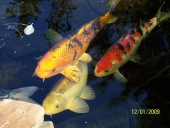




Idle dreamer




















Check out my Primal Prepper blog where I talk about permaculture, prepping, and the primal lifestyle... all the time! 








Idle dreamer









Idle dreamer









Idle dreamer





Idle dreamer








www.thehappypermaculturalist.wordpress.com








fyl Hatfield wrote: With a little bit of creative design, feeding could be automated (with no moving parts other than the larva).
Idle dreamer




Tyler Ludens wrote:The only problem with BSF larvae is they seem to be seasonal. But could be used in conjunction with other critters such as Red Wigglers and crickets.





Manitou Designs wrote: Ok, here goes my 2 cents...
"When your using the grow beds you're removing a lot of soil biology that normally would interact with the plants. Does that have an effect on the benefits the plants offer im not sure."
I am a newbie and not practicing aquaculture at the moment, but I have stocked my library with all kinds of books related to the transmutation of elements by microbes and plants, to the importance of creating vortices in water which can generate electrical charges which then assist in the creation of colloids (nutrients which are more easily absorbed by plants).
With this in mind, heavy metals and toxins can be neutralized by certain water plants making the issue of using plastic or PVC piping the lesser of evils in aquaculture. What is really dangerous is the anaerobic conditions where the bad bacteria live. Aerating by bubbling or letting the water fall from a higher level mimics the effects of naturally occuring rapids in a stream...thus creating a filmy colloid around microscopic particles which are easily absorbed by the toxin-loving plants.
I found that taking the time to study Nature reveals many answers to our questions.
If you are raising freshwater fish, like tilapia, go ahead and find a local creek or stream to introduce biological micro-organisms... even the mud has beneficial microbes. And introduce these with the filtration tank and purifying plants. I have included a link which will explain more thoroughly:
http://www.thegreencenter.net/








A human being should be able to change a diaper, plan an invasion, butcher a hog, conn a ship, design a building, write a sonnet, balance accounts, build a wall, set a bone, comfort the dying, take orders, give orders, cooperate, act alone, solve equations, analyze a new problem, pitch manure, program a computer, cook a tasty meal, fight efficiently, die gallantly. Specialization is for insects.
-Robert A. Heinlein








fyl Hatfield wrote:This post is inspired by Paul's comments in podcast 120. I pretty much agree that aquaponics is not pure permaculture but I also don't want to write it off as a bad idea. Like any idea, it can evolve into the ultimate Capitalist exploitation (in this case, mostly of fish) or it can be a reasonable approach to address a particular situation. Here's mine.
I live in rural Nicaragua. While I have access to a lot of land there are many poor Nicaraguans here that are pretty much subsistence farmers. Their diets tend to be mostly beans and corn with possibly some eggs tossed in. Green veggies are close to nonexistent.
What I want to do is develop what I will call the campasino aguaponics package. That is, some minimalist system using typical materials found here such that with little invest, a diet change could be effected. My scribbles about this are at Aguaponics for the people. I confess that being a geek I am getting carried away with some automation (which will be optional) but the goal is simple: greens for the people.
Paul's concern about cruelty to fish is real. Each new aquaponics article I read suggests higher densities. This is just like chicken farms. But, systems can be designed where fish density is lower.
One other issue is food. I am looking at black soldier fly larva as one possible food source. Again, that would not be the answer for those developing commercial aquaponics systems but it could fit in well with what I want to do. With a little bit of creative design, feeding could be automated (with no moving parts other than the larva).










| I agree. Here's the link: http://stoves2.com |
.jpg)





